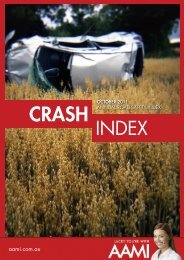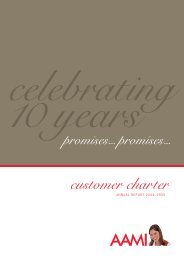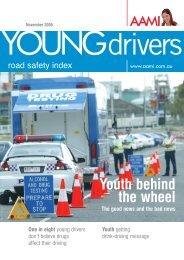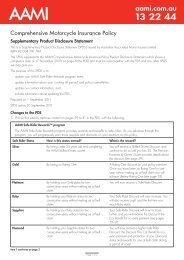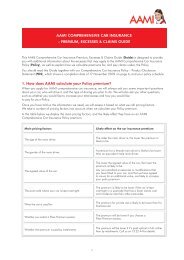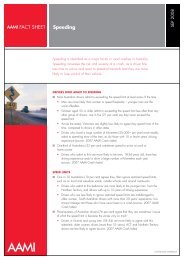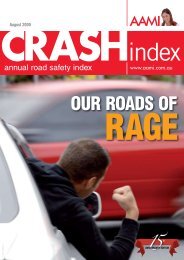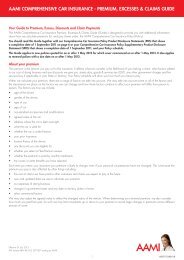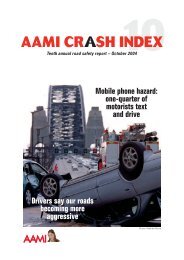2007 AAMI Firescreen Fire Safety and Awareness Index
2007 AAMI Firescreen Fire Safety and Awareness Index
2007 AAMI Firescreen Fire Safety and Awareness Index
- No tags were found...
Create successful ePaper yourself
Turn your PDF publications into a flip-book with our unique Google optimized e-Paper software.
June <strong>2007</strong>FIREscreenfire safety <strong>and</strong> awareness index www.aami.com.au10informing the communityabout fire safetyDoing it forthe kidsMost parents discuss fire safety withchildren... but many admit their childrendon't know how to h<strong>and</strong>le home fires.
This is the tenth annual <strong>AAMI</strong> <strong><strong>Fire</strong>screen</strong> • Adelaide • Darwin • Sunshine Coast This independent survey research is<strong>Index</strong>. It is published to raise awareness • Ballarat, Bendigo • Geelong • Sydney supported by an in-depth analysisabout the common locations <strong>and</strong> causes <strong>and</strong> Shepparton • Gold Coast • Tamworth of home insurance claims lodgedof home fires <strong>and</strong> provides residents • Batemans Bay, • Hobart • Toowoomba <strong>and</strong> in 2006 by <strong>AAMI</strong> customers inwith advice on how to prevent home fires Bega <strong>and</strong> Ulludulla • Launceston the Darling Downs all States <strong>and</strong> Territories, exceptbreaking out. • Brisbane • Melbourne • Wagga Wagga Western Australia.The <strong>AAMI</strong> <strong><strong>Fire</strong>screen</strong> <strong>Index</strong> is based on • Canberra • Newcastle <strong>and</strong> <strong>and</strong> Griffithan independent study of Australians’ • Central Gosford • Wollongong <strong>and</strong>attitudes <strong>and</strong> experiences of fire in theQueensl<strong>and</strong> • North Queensl<strong>and</strong> Nowrahome. It is based, in part, on a survey of2382 adults in the following locations:• Coffs Harbour <strong>and</strong>Port Macquarie• RegionalSouth AustraliaHome is where the fire isNationally almost one-quarter ofAustralians (23 per cent) haveexperienced a fire at home.South Australians are most likelyto have experienced a home fire(30 per cent) while people in theNorthern Territory are least likely tohave had this experience (18 per cent).Kitchens are the major hotspot forhome fires in Australia: more than half(53 per cent) start in the kitchen, <strong>and</strong>TEN KEY FINDINGS12345678910FOR ONE IN17 VICTIMS(6 PER CENT),THE FIREDESTROYEDTHE ENTIREHOMEalmost half (44 per cent) are caused bya cooking incident. The second mostcommon starting place for home fires isthe living room/lounge room — one in tenhome fires start there.One in eight home fires (12 per cent)are caused by faulty electrical equipmentor fixtures.While most home fires (89 per cent)are confined to the room where the firestarted, in many cases it spreads to oneor more rooms. For one in 17 (6 percent), the fire destroyed the entire home.<strong>Fire</strong> – a common experience: Almost one-quarter of Australians (23 per cent) haveexperienced a home fire.Heat in the kitchen: More than half of all home fires (53 per cent) start in the kitchen, <strong>and</strong>44 per cent are caused by a cooking-related incident.0Electrical equipment sparks concern: Faulty electrical equipment or fixtures are responsiblefor one in eight home fires (12 per cent).<strong>Fire</strong> is not child’s play: Incidents caused by children playing with matches or lighters areresponsible for 3 per cent of home fires.A recipe for disaster: One in eight (12 per cent) Australians with children (3-12) admit theyallow their children to cook unsupervised.Child safety – a delicate balance: One in four parents (24 per cent) said their children wouldnot know what to do in the event of a house fire.Get out of the house: Half of Australians (47 per cent) households have a home fire escapeplan in place.Smoke alarms on the rise: Most Australian homes (93 per cent) have at least onesmoke detector.Protecting against the worst: Should a fire totally destroy a home <strong>and</strong> its contents, only15 per cent of Australians do not have insurance of any kind.Insuring for change: For one in 20 (5 per cent) Australians, it has been at least five yearsor more since they last updated their contents insurance.Fail to plan or plan to failAlthough most Australians (72 per cent)say they would know the best responseto a fire that started in their home,only half (47 per cent) have a homefire escape plan in place whereby allmembers of the household would knowwhat to do.Most Australian homes (93 per cent)have at least one smoke detector,one in three (31 per cent) have a fireextinguisher, <strong>and</strong> one in five (22 per cent)have a fire blanket. Alarmingly, one in20 Australian homes (5 per cent) have nofire prevention equipment whatsoever.Only one in five Australians (22 per cent)strongly agree that they would know howto use a fire extinguisher in the event ofa fire. Most people (72 per cent) agreethey should have more equipment in theirhome to deal with a fire.Of the 93 per cent of Australians whohave a smoke alarm in their home,one in 10 (10 per cent) admit they donot regularly check that it is in goodworking order.Switch off the dangerWhile electrical appliances cause onein eight home fires (12 per cent), asignificant proportion of Australiansdeliberately leave electrical appliancesrunning <strong>and</strong> unattended.The family washing machine is theappliance most commonly left runningwhen people leave the home (49 percent), followed by the television(29 per cent), dishwasher (27 per cent),air conditioner (23 per cent), stereo
Kids in the kitchenWith many parents engaged in full <strong>and</strong> part-time employment, their willingnessto allow their children to cook unsupervised is of some concern.Of the Australian households with children aged 3-12, one in eight (12 per cent)admit they allow them to cook unsupervised. This, together with evidence thatcooking is the cause of 44 per cent of home fires, is potentially a recipe for disaster.Despite this, parents are generally proactive in discussing the dangers of fire withtheir children: most (86 per cent) say they have talked to their kids about fire danger.However, there is room for improvement given that one-quarter of Australianparents (24 per cent) said their children would not know what to do in the eventof a fire in the home.This is worrying given almost one in 10 (9 per cent) home fire incidents involvechildren.Of those who have had this experience, one in five (21 per cent) consideredthe incident very serious <strong>and</strong> almost half (48 per cent) reported it wassomewhat serious.While parents seem willing to let their children cook unsupervised, they are lesslikely to allow them easy access to matches. More than half (62 per cent) ofparents keep matches locked away from young children, which is of somecomfort considering that 3 per cent of home fires are believed to have beencaused by children playing with matches or lighters.(19 per cent) <strong>and</strong> clothes dryer (15 percent). One in 20 (5 per cent) Australiansleave their ovens on whilst unattended.Heaters are the least likely of appliancesto be left running unattended, althoughone in 17 Australians (6 per cent) allowthis to happen. This is of some comfortgiven that only half of all Australians (54per cent) check the safety of their heatingappliances before putting them into useover winter.more important to be able to escape thehome safely in the event of a fire thatcannot be extinguished. Therefore, it is ofconcern that approximately one-third ofall Australians (28 per cent) do not leavekeys in deadlocked doors or windows.Despite this, Australians are generallylikely to take other basic measures tosafeguard their home <strong>and</strong> its surroundsagainst fire breaking out:• 62 per cent of Australians regularlyclear their gutters of leaves <strong>and</strong> otherDeadlocked doors makedebris <strong>and</strong> build-up; <strong>and</strong>for deadly escape • 67 per cent regularly prune branchesWhile it is important to be well-equipped<strong>and</strong> foliage surrounding their homes.to prevent, <strong>and</strong> be able to respond Only one in eight Australians (12 pereffectively to, a fire in the home, it is even cent) believe their home is a fire risk.IT IS OFCONCERN THATAPPROXIMATELYONE-THIRDOF ALLAUSTRALIANS(28 PER CENT)DO NOT LEAVEKEYS INDEADLOCKEDDOORS ORWINDOWSSunday bloody SundayNationally, most home fires (17 percent) are likely to occur on a Sundaybetween 4pm <strong>and</strong> 8pm when mostfamily members are home, according to2006 <strong>AAMI</strong> insurance claims data.Of all <strong>AAMI</strong> fire claims in 2006, onein five (20 per cent) started in theearly evening, which is consistent withfindings that most fires begin in thekitchen (53 per cent) <strong>and</strong> that44 per cent are caused by cooking.Homes with no fire prevention equipment by stateUnderinsurance is a fire riskFortunately, fires that result in thecomplete loss or destruction of home<strong>and</strong>/or contents are uncommon. In the5% 3% 10% 1% 5% 15% 16%NSW VIC QLD SA TAS ACT NTHOMES WITH NO FIRE PREVENTION EQUIPMENTHomes with no fire prevention equipment by stateEXPERIENCES OF HOME FIRESExperiences of home fires22%22%23%30%25%24%18%5% 3% 10% 1% 5% 15% 16%NSW VIC QLD SA TAS ACT NTSource: <strong>2007</strong> Sweeney ResearchNSW VIC QLDSource: <strong>2007</strong> Sweeney ResearchSATASACTNT
0% 1% 5% 15% 16%LD SA TAS ACT NTperiences of home fires3% 30% 25%QLD SA TAS24%ACT18%NTCAUSE OF FIRECause of fireCooking 44%Faulty electrical appliance/fitting 12%Homes with no fire prevention equipment by stateBushfire 5%C<strong>and</strong>les/oil burners 4%Cigarette 4%Open fire 4%Children playing with matches/lighters/petrol 3%Radiator various incidences/heater 3%Flammable liquid/gas/gas leak 2%Deliberately lit/arson 3%Stove accidents/incidents various 2%5% 3% 10% 1% 5% 15% 16%Other 14%NSW VIC QLD SA TAS ACT Source: <strong>2007</strong> NTSweeney Researchare more confident that they have ONLY THREE IN policy that guarantees the completeenough insurance to cover themselves 10 AUSTRALIANS replacement of the policyholder’s home,ome fires by time of dayagainst complete (29 PER CENT)Home loss fires of by their day home of weekregardless of cost. Cause of firePMcontents Experiences – two-thirds of (65 home per fires cent) admit BELIEVE THATSunday 17% THEY HAVE This st<strong>and</strong>ard Complete Replacement Cooking 44%they would be adequately covered forFaulty electrical applHomes with no fire prevention equipment by stateENOUGH Cover benefit addresses the commonthis.Monday 15%Bushfire 5%INSURANCE TO pr oblem of underinsurance. According C<strong>and</strong>les/oil burnersWhen asked why their contentsTuesday 12%COVER AGAINST to a 2005 report by the Australian Cigarette 4%were insured for less than their full THE COMPLETE Securities <strong>and</strong> Investment Commission Open fire 4%22% replacement 22% 23% value, 30% 43 per cent 25% of 24% Wednesday L18% OSS 11% ORChildren playing with( ASIC), 70 per cent of Australian homes20% 25% 28% 14%Australians said that they had not DESTRUCTION OFRadiator various inciThursday 16%are underinsured against their completeTHEIR HOMEFlammable liquid/gaupdated their insurance after acquiringreplacement in the event of total loss Deliberately or lit/arson8 am MIDDAY 4 pm 8 pmadditional items, one in seven (14 per Friday 14%rare event of a fire that results in thedestruction.Stove accidents/inci– MIDDAY – 4 pm – 8 pm – MIDNIGHT5% 3% 10% 1%NSW5% cent) VIC 15% saidQLDthe 16% likelihoodSAof theirTAShomeACT NTcomplete destruction of a home <strong>and</strong> itsOther 14%being completely destroyed is remote, Saturday 15%contents, NSW it VIC is reassuring QLD that SA only TAS ACT NT<strong>and</strong> one in 11 (9 per cent) said their15 per cent of Australians do not have<strong>Fire</strong> <strong>and</strong> Theft Contents Coverbelongings were not worth insuringany insurance protection against this– some relief for rentersfor their full value.kind of loss.Home fires by day of weekRenters are amongst Australia’s mostAlmost half Home (45 fires per by cent) time of Australians dayMany Australians (66 per cent) arevulnerable householders – four in 10have AM not updated their contents PMCause of fireHome fires by day of weeks Incidence Rates (per 1000 policies)insured against damage to or loss of their(39 per cent) have no home contentsExperiences of home fires insurance in the last 1-5 years, <strong>and</strong> 4 perCooking 44%Sunday 17%home. Most (80 per cent) are coveredinsurance whatsoever. However,cent have not Sundone so MonFaulty electrical appliance/fitting 12%in the last 6-10against loss of their home contents,renters are susceptible to home fire –years. One 17% 15%Bushfire 5%Monday 15%in 25 Australians (4 per cent)<strong>and</strong> 43 per cent have extra cover toC<strong>and</strong>les/oil one-quarter burners (24%per cent) report havingdo not know, or cannot remember,TueSatwhenTuesday 12%protect against the loss or destruction of12%Cigarette had this 4% experience.they last 15% updated their insurance.Open fire 4%personal valuables, such as jewellery <strong>and</strong><strong>AAMI</strong>’s <strong>Fire</strong> <strong>and</strong> Theft Contents Wednesday 11%22% 22% 23% 30% 25% 24% 18%WedChildren playing with matches/lighters/petrol 3%1.70 original 2.40 works of 4.20 art. 1.90 6% 7% Fri20% 25% 11% 28% 14%ThuInsurance Policy provides protectionThursday 16%Only three in 10 Australians (29 per cent) CompleteRadiator various incidences/heater 3%Replacement 16% CoverFlammable liquid/gas/gas leak 2%for renters against the two major risks:MIDNIGHT8 pmbelieve that they have enough insurance – 4 against am the 8 am unthinkableDeliberately lit/arson 3%MIDDAY 4 pmfire <strong>and</strong> theft. The policy is designed Friday for 14%QLDSA TAS ACT– 4 am – 8 am – MIDDAY – 4 pm – 8 pm – MIDNIGHTStove accidents/incidents various 2%to NSW cover against VIC the QLD complete SAloss or TAS<strong>AAMI</strong>ACTis theNTonly major Australian insurerOther people 14% who want a simple, affordableSaturday 15%destruction of their home. However, they to provide a home building insurancepolicy to protect their household assets.Home fires by day of weekHOME FIRES BY TIME OF DAYHome fires by time of dayHome fires Claims Incidence Rates (per 1000 policies) Home fires by day of weekAMPMSunday 17%Sun MonMonday 15% 17% 15%TueTuesday Sat12%15%12%Wednesday 11% Wed1.70 2.10 1.70 2.40 4.20 1.90Fri11%6% 7% 20% 25% 28% 14%14% ThuThursday 16%16%MIDNIGHT 4 am 8 am MIDDAY NSW 4 pmVIC8 pmQLDSA TAS ACTFriday 14%– 4 am – 8 am – MIDDAY – 4 pm – 8 pm – MIDNIGHTSource: 2006 <strong>AAMI</strong> Claims DataSaturday Source: 15% 2006 <strong>AAMI</strong> Claims DataHOME FIRES BY DAY OF WEEK
CHILD SAFETY IS NO ACCIDENTDR MARK STOKES, PHD BBSC (HONS) CBS MAPS MCHP MCOPPRESIDENT, KIDSAFE VICTORIA INC.Burns are a permanent injury leadingto extensive, expensive medical care<strong>and</strong> often immense psychologicaldamage. This is why fire safety is acritical element in any home, play areaor workplace.The majority of child deaths <strong>and</strong>injuries due to fire occur in the home.Most of these are preventable throughthe implementation of simple strategies.With many parents admitting that theirchildren would not know what to doin case of a fire, there is obviously astrong need for parent <strong>and</strong> caregivereducation as to how they can maketheir homes safer for children.Parental vigilance is the key elementin preventing fires. Ensuring matches,lighters, irons <strong>and</strong> electrical cords arestored out of reach of curious childrenis essential. Heaters should be placedaway from curtains, furniture, clothing,bedding <strong>and</strong> other flammable material.When purchasing children’s nightwear,choose wool or cotton rather thanpolyester clothing <strong>and</strong> look for clothingwith a ‘low fire risk’ tag. Good practicerequires that all heaters <strong>and</strong> appliances(especially tumble dryers) are turnedoff before going to bed or leavingthe house.The installation of electrical safetyswitches to protect against faulty wiringor products is a good safety measurefor parents. Regularly checking <strong>and</strong>replacing any electrical applianceswith frayed cords, <strong>and</strong> ensuring thatelectrical power boards <strong>and</strong> switchesare not overloaded are simple activitiesthat can reduce the risk of fire inyour home.Similarly, the prevention of contactburns can be achieved through parentalvigilance. Relatively simple acts suchas installing guards around fireplaces,heaters <strong>and</strong> on top of stoves are agood start. Installing safety gates inkitchen <strong>and</strong> BBQ areas will help keepchildren away from these potentiallydangerous areas.Preventing injury in the case of a fire isabout being prepared. Installing smokealarms, <strong>and</strong> regularly testing <strong>and</strong>replacing their batteries is a m<strong>and</strong>atoryprecaution. Of equal importance ishaving a fire escape plan that youpractice with your children at leasttwice a year. Teach your children whatto expect in a fire.Have fire extinguishers <strong>and</strong> fire blanketseasily accessible in your home. Placethese at least three metres away fromthe potential source of a fire, such asa stove, oven or fireplace, to ensureaccess is not impeded.All families should be prepared for a fireby discussing <strong>and</strong> implementing thesesimple strategies with their children.By following these steps you areminimising the risk of fire-related injuryor death to your child… after all Child<strong>Safety</strong> is No Accident!TEN TOP FIRE SAFETY TIPS12345Have an adequate number of suitable smokealarms installed throughout your home <strong>and</strong>make sure that you test them regularly.0If you have a fireplace, always place a screenin front of it when in use, <strong>and</strong> keep the chimneyclean.Develop a home escape plan <strong>and</strong> rehearse itwith all the members of your household.Check electric blankets for damage or frayedcords before placing them on the bed. To testan electric blanket, lay it flat on top of the bed,then switch it on for five minutes to confirm itis OK, before affixing it to the bed.Take care to keep curtains, tablecloths <strong>and</strong>bedding away from portable heaters.678910Keep wet clothing at least one metre fromheaters or fireplaces.If you use a clothes dryer, ensure you clean thelint filter each time you use it.Always use c<strong>and</strong>les <strong>and</strong> open flames with care<strong>and</strong> extinguish them before going to bed or theleaving the home.Store matches <strong>and</strong> lighters in a secure placenot accessible to young children.Use only authorised installers of fixed heatingappliances. Oil, gas or wood heating units mayrequire a yearly maintenance check.
Courtesy of the NSW <strong>Fire</strong> BrigadesAlways call 000 in case of emergencyBUILD YOUR OWN FIRE ESCAPE PLANOn <strong>AAMI</strong>’s website – located at www.aami.com.au –you <strong>and</strong> your children can draw your own fire escapeplan <strong>and</strong> play the fire escape game. The fire escapegame tests children’s fire safety knowledge <strong>and</strong>improves their underst<strong>and</strong>ing of fire dangers.By involving children in developing <strong>and</strong> practisingyour family’s home fire safety plan, you also increaseyour child’s ability to get out of the house safely,should a fire occur.The <strong>AAMI</strong> <strong><strong>Fire</strong>screen</strong> <strong>Index</strong> is prepared with the help of using a representative <strong>and</strong> statistically valid sample research may differ from government <strong>and</strong> policenationally recognised independent research company of 2382 Australian adults in major population centres agencies whose research is typically limited to aSweeney Research, which ensures the validity of the across Australia. 12-month period. Also, smaller or unreportedsurvey methodology <strong>and</strong> findings. The study is based Except where stated, the survey explored respondents’ incidents may be captured in <strong>AAMI</strong>’s research buton a national telephone survey conducted in <strong>2007</strong> experiences of home fires over their lifetime. <strong>AAMI</strong>’s not by others.vPRINTED ON RECYCLED PAPERPO111P067




